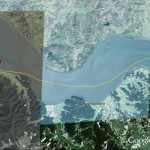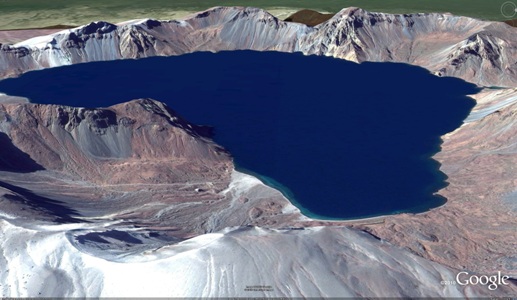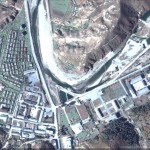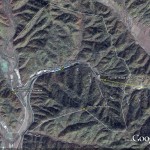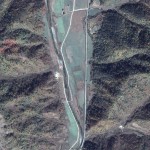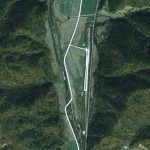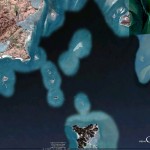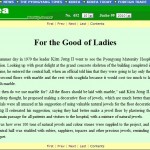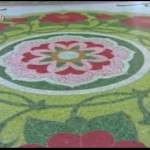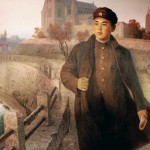According to the Daily NK:
North Korea’s attack on Yeonpyeong Island on November 23rd has caused a spate of rice price instability in the markets. Even though it is December, rice is now selling for around 1,300 won per kilo, as much as 500 won more than it was just one month ago.
This is contra to the normal trend, which is that the price of food generally declines because farmers on collective farms get food distribution from the state at this time.
A source from North Hamkyung Province explained the details to The Daily NK yesterday, saying, “The price of rice, which was between 800 and 900 won in mid-November, started going up on around the 23rd, and is now over 1,300 won.“
“People have been taken aback by the soaring food prices,” he added
According to the source, on the 8th and 9th the rice price in Hoiryeong Market apparently hit 1,900 won, the highest this year.
This phenomenon, which is rare but not unprecedented, seems to have been caused because the North Korean authorities are trying to raise domestic and international tension on the Korean Peninsula.
An example of this can be seen in a statement released by a North Korean “social organization”, Chosun Peace Protection National Committee, on the 11th, in which it proclaimed, “Our military and the people are both prepared for either expanded skirmishes or all-out war.”
Elsewhere, people’s unit lectures over the last few weeks have focused on asserting phrases like this one, heard in a northern provincial city lecture, “Since the current situation is extremely tense, you have to live lives appropriate to that tension.”
This atmosphere naturally has spilled over into the markets, where food wholesalers and the “donju,” holders of large amounts of capital, have reacted negatively, according to the source, who explained, “The latest mood is similar to the time when the authorities declared a ‘Quasi-war Footing’ in 1993. As the atmosphere gets more serious, money holders begin to obtain and cling onto foreign currency, so foreign currency dealing and circulation volumes fall and food trade is choked off. Therefore, rice prices soar.”
In additional, military tensions between North and South are having an influence on trade between the North and China, so the amount of Yuan flowing into North Korea has also shrunk, which is another cause of rising currency exchange rates and therefore domestic rice prices.
The source said, “People are saying that this happened because of the gunfight between the North and South,” going on, “For this troubling rumor that a war could break out, smuggling volumes between North Korea and China have also shrunk.”
Although rice has now settled back to 1300 won from its high of 1900 won, the source said many people are still concerned for the winter season.
“Since the 10th, the Yuan has gone down to 330 or 340 won, so the rice price has dropped to around 1,300 won accordingly,” the source said. “But we are worried about whether or not we can afford to eat enough corn porridge this winter.”
The Daily NK has also conducted an additional investigation of currency rates and rice prices in Pyongyang, Shinuiju and Hyesan, comparing December 7th to 13th with November 24th to 30th, to check the effect of this trend across the country.
In the North Korean capital, one U.S. dollar has increased from 1,400 won to 1,750 won, while rice has gone from 750 won to 1,250 won per kilo.
In Shinuiju, meanwhile, both foreign currency exchange rates and rice prices are marginally worse again, moving from 1,450 to 1,800 won per dollar and from 800 won to 1,300 won per kilo respectively, while in Hyesan, the dollar exchange rate mirrored that in Pyongyang, but rice had been hardest hit, going from 900 won to 1,350 won.
Additionally, in Shinuiju on the 9th one Yuan had soared to 420 won, near the level of the period before the redenomination.
This December 2010 price trend is occurring for the third time since 2000. The first was in December, 2005 when the authorities stopped all food trade because the state apparently planned to resume full food distribution. Thereafter, rice prices almost doubled. The second time was in December last year, a phenomenon caused by a measure shutting down the market following the currency redenomination.
According to the Korea Times:
North Korean merchants are exchanging their local currency en masse as war jitters in the wake of Pyongyang’s attack on Yeonpyeong Island have stoked fears that the won may lose its value in the case of war, a report said.
According to North Korea Intellectuals Solidarity (NKIS), a Seoul-based NGO comprised of defectors with lines into the North, currency exchange rates have skyrocketed since the Nov. 23 incident. One hundred yuan, which before the shelling went for 2,000 won, is now worth 35,000 won, NKIS said in a report released Sunday.
“Merchants have heard rumors that if there is war, North Korean bills will become worthless scraps of paper,” NKIS quoted a source as saying, causing traders to exchange their won while they can.
Price of daily goods have also skyrocketed, the report said, with rice jumping from 900 won per kilogram to 1,600 won. Corn climbed from 4,000 won per kilogram to 6,000 won, it said.
The source said the soaring prices have been caused by jitters in the market over the heightened tensions in the wake of the Nov. 23 attack, saying the North’s military has been in a “quasi state of war” since the incident.
The rumors that the won will lose its value in case of a war have slowed market activities as merchants have raised prices and are waiting to see if further military action is on the cards.
Traders in China, from who markets in the North secure much of their goods, have also become reluctant to make transactions involving North Korean currency and are trading what won they have, the source said.
The price jump comes on the heels of reportedly enormous inflation caused by a botched currency reform last year.
The regime redenominated banknotes at a ratio of 100:1 in November last year in a move to squelch a bourgeoning private sector. But the move led to runaway inflation as the price soared by some forty times within the year, according to reports.
The U.N. estimated last month that some 5 million North Koreans will face food shortages this year due to lack of staple grains, while the economy is believed to be suffering heavily from international sanctions imposed for the regime’s missile and nuclear tests.
Meanwhile, Pyongyang, which claims Seoul instigated the shelling by firing into its territory during a military drill, continued to threaten the South over the weekend, saying, “The army and the people of the DPRK are ready for both an escalation and an all-out war.”
According to the Institute for Far Eastern Studies:
After North Korea rained artillery onto Yeonpyeong Island, military tensions have continued to grow, impacting the price of rice and the currency exchange rate in the North”s traditional markets. On December 13, NK Intellectual Solidarity reported that this has shaken the livelihoods on North Korean people. According to the group, rice has shot up 77 percent, from 900 won to 1600 won per kilogram, since the November 23 attack. The price of corn has also gone up by 50 percent, to 600 won per kilogram. At the same time, the exchange rate for Chinese yuan has risen, at least in the market in Hyeryong, from 220 to 350 won per yuan, a 59 percent increase.
Daily NK has also reported that post-Yeonpyeong food price increases have been significant, and as the Autumn harvest comes to a close in December, smaller rations to those working on collective farms is expected. A contact in North Hamgyong Province reported, “Rice prices that were 800-900 won [ per kilogram] in mid-November shot up to 1100 won and have recently risen to 1300 won…people are reeling at the sudden rise in prices.” According to the source, rice hit a high of 1900 won in the Hyeryong market around December 8-9.
The very first to reflect military tensions between the to Koreas were money handlers and wholesalers. A source in North Korea compared today”s atmosphere with that experienced in 1993, and explained that as people”s concerns about war increase, money traders become more conservative, tightening up the exchange of currency and therefore slowing the entire wholesale market, driving up prices. A survey by DailyNK from December 7-13 revealed that the exchange rate in Pyongyang rose from 1400 to 1750 won between November 24 and the end of the month, while the price of rice rose from 750 won to 1250 won per kilogram over the same period. In Sinuiji, the exchange rate rose from 1450 to 1800 won, while rice costs went up from 800 to 1300 won per kilogram. Hyesan showed similar trends, with the exchange rate rising from 1400 to 1800 won and rice rising from 900 to 1350 won per kilogram.
While food prices have fallen from their peak after the Yeonpyeong shelling, they are still high enough to cause significant difficulties for the average North Korean. Price hikes seen recently are three times as severe as those seen from 2000-2010, including the huge jump seen in 2005 when authorities attempted to reintroduce the central rationing system. Combined with last year”s failed currency reform attempt, the latest price hikes have severely strained the livelihoods of most North Koreans.
UPDATE: From the Institute for Far Eastern Studies
DPRK prices, exchange rate, skyrocket after shelling
Institute for Far Eastern Studies (IFES)
NK Brief No. 10-12-15
12/15/2010
After North Korea rained artillery onto Yeonpyeong Island, military tensions have continued to grow, impacting the price of rice and the currency exchange rate in the North”s traditional markets. On December 13, NK Intellectual Solidarity reported that this has shaken the livelihoods on North Korean people. According to the group, rice has shot up 77 percent, from 900 won to 1600 won per kilogram, since the November 23 attack. The price of corn has also gone up by 50 percent, to 600 won per kilogram. At the same time, the exchange rate for Chinese yuan has risen, at least in the market in Hyeryong, from 220 to 350 won per yuan, a 59 percent increase.
Daily NK has also reported that post-Yeonpyeong food price increases have been significant, and as the Autumn harvest comes to a close in December, smaller rations to those working on collective farms is expected. A contact in North Hamgyong Province reported, “Rice prices that were 800-900 won [ per kilogram] in mid-November shot up to 1100 won and have recently risen to 1300 won…people are reeling at the sudden rise in prices.” According to the source, rice hit a high of 1900 won in the Hyeryong market around December 8-9.
The very first to reflect military tensions between the to Koreas were money handlers and wholesalers. A source in North Korea compared today”s atmosphere with that experienced in 1993, and explained that as people”s concerns about war increase, money traders become more conservative, tightening up the exchange of currency and therefore slowing the entire wholesale market, driving up prices. A survey by DailyNK from December 7-13 revealed that the exchange rate in Pyongyang rose from 1400 to 1750 won between November 24 and the end of the month, while the price of rice rose from 750 won to 1250 won per kilogram over the same period. In Sinuiji, the exchange rate rose from 1450 to 1800 won, while rice costs went up from 800 to 1300 won per kilogram. Hyesan showed similar trends, with the exchange rate rising from 1400 to 1800 won and rice rising from 900 to 1350 won per kilogram.
While food prices have fallen from their peak after the Yeonpyeong shelling, they are still high enough to cause significant difficulties for the average North Korean. Price hikes seen recently are three times as severe as those seen from 2000-2010, including the huge jump seen in 2005 when authorities attempted to reintroduce the central rationing system. Combined with last year”s failed currency reform attempt, the latest price hikes have severely strained the livelihoods of most North Koreans.
Read the full stories here:
Tensions Driving Rice Price and Exchange Rate Hikes
Daily NK
Yoo Gwan Hee
12/14/2010
DPRK prices, exchange rate skyrocket after shelling
Institute for Far Eastern Studies (IFES)
NK Brief No. 10-12-15
12/15/2010
‘Yeonpyeong shelling causes inflation in Pyongyang’
Korea Times
Kim Young-jin
12/13/2010

